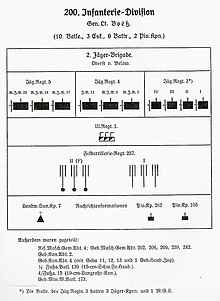Carpathian Corps
The Carpathian Corps (as officially written) was a major unit of the German army during the First World War , which existed from 1916 to 1918.
Compilation
When it was formed , the corps was subordinate to the Austro-Hungarian 7th Army , which at that time was led by Archduke Karl , the later Austrian Emperor.
It comprised the 1st Division ( Königsberg ) with the Grenadier Regiment "Kronprinz" (1st East Prussian) No. 1 , Grenadier Regiment "King Friedrich Wilhelm I." (2nd East Prussian) No. 3 and the Infantry Regiment " Duke Karl von Mecklenburg-Strelitz ”(6th East Prussian) No. 43 .
Then there was the newly formed 200th division . It consisted of the Jäger Regiment 3 , which had previously belonged to the Alpine Corps , and the newly established Jäger Regiments 4 and 5 .
The headquarters of the headquarters of the Carpathian Corps were in Ruszpolyana . The forerunner was the Bothmer Corps . He had belonged to the 1st Division , which took part in the 1915 Carpathian Battle and was subordinate to the Austro-Hungarian Army under Karl von Pflanzer-Baltin .
history
To support the Austro-Hungarian armed forces on the Eastern Front , the IV Reserve Corps was relocated to the Hungarian Carpathians in August 1916 . From then on it was called the "Carpathian Corps" and was deployed from August 1916 to the end of 1917 in the north of the Romanian front , where the Bukovina was finally completely retaken . General of the infantry Richard von Conta acted as commanding general .
In recognition of the protection of Hungary by the corps, Emperor Franz Joseph I awarded the members of the Carpathian Corps the Carpathian Corps badge . The badge, a deer antler with broken fir and sword, was made according to the design of a member of the Reserve Jäger Battalion No. 23 fighting in Jäger Regiment 5 from Goslar . It was worn on the cap between the two cockades .
Members of the Jäger Regiment 5 , subordinate to the 200th Division , who had already been awarded the Iron Cross 2nd Class, were given an honorary deer by the regiment for services that would have resulted in the "Iron Cross 1st Class" excellent. Engraved on it:
“For excellent bravery before the enemy - Jäger-Rgt. 5 "
Battle calendar
After its formation, the division was initially deployed on the Eastern Front, transferred to the Italian Front in mid-September 1917 and then fought on the Western Front from February 1918 until the end of the war .
1916
- August 1st to 26th - Fights for Baba-Ludowa and at Jablonitza
- August 2nd - Storming of Hala-Mihailewa and Hala-Lukawiec
- August 3rd - Storming of Watonarka and Ludowa
- 4th to 6th August - persecution on Jablonitza
- August 6th - on Plaik
- August 7th to September 2nd - fights near Jablonitza and in the Skupovo region
- August 11 - Skupova
- August 11th to 31st - fighting on the Tatar Pass and in the Ludowa area
- August 17th to September 5th - Fights at Pnewie
- August 19-20 - Storming of Kréta and Stepanski
- August 21 to September 2 - fighting for Munczel and Gora-Piaskowa
- August 27th to September 8th - fights near Listowaty
- September 1st to 29th - September battle in the Carpathian Mountains
- September 3-29 - Battle of the Ludowa area
- from October 1st - trench warfare in the Western Carpathians
1917
- until July 24th - trench warfare in the Western Carpathians
- July 25th to August 10th - Liberation of Bukovina
- August 11th to September 16th - trench warfare on the eastern border of Bukovina
literature
- Hermann Cron: History of the German Army in the World War 1914–1918. Military publisher Karl Siegismund, Berlin 1937 ( History of the Royal Prussian Army and the German Imperial Army 5).
- The Goslar Jäger in the World War.
- III. Volume: Walter Holste: The Reserve Jäger Battalion No. 23. With appendix: The Association of Former Goslar Jäger. , Lax printing house, Hildesheim 1934.
Web links
- The highest command posts in the army. on www.deutsche-kriegsgeschichte.de (as of May 6, 2010)
- Battle sheets of the Carpathian Corps

